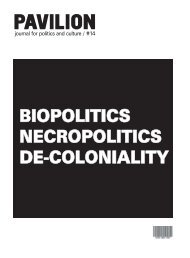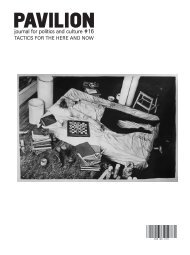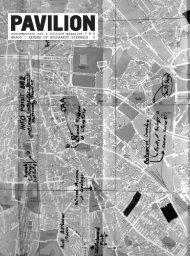PAVILION
PAVILION
PAVILION
- No tags were found...
Create successful ePaper yourself
Turn your PDF publications into a flip-book with our unique Google optimized e-Paper software.
metropolis in which the outlines of an<br />
entire epoch could be discerned in distorted<br />
form, have not simply been frozen<br />
into the opaque mirror-worlds of postmodernity<br />
so poignantly captured in the<br />
self-referential corporate hotel. As<br />
Jameson intimates but does not fully<br />
develop, they have been displaced onto<br />
a different plane, to which architecture<br />
provides only indirect access. So we cannot<br />
be content to compare the hotel lobbies<br />
of Pudong circa 2000 to the hotel<br />
lobbies of Berlin circa 1930. Instead, we<br />
must read architecture and urban form<br />
not only as tangible, material evidence of<br />
the abstraction of modern life, but also as<br />
abstraction itself.<br />
Take Mumbai, or New York. In many<br />
ways these two cities epitomize the workings<br />
of what we can call the financial<br />
imaginaries of globalization, which we<br />
can think of as a modification of what<br />
Simmel called the Nervenleben, or “mental<br />
life,” of the modern metropolis.<br />
Financial imaginaries are cultural constructions<br />
through which circulate other<br />
cultural constructions, like “money,”<br />
“credit,” and “architecture.” All imaginaries<br />
belong to the realm of social practice,<br />
and my use of the term relies on its development<br />
in the work of such figures as<br />
Cornelius Castoriadis, Benedict<br />
Anderson, Arjun Appadurai, and Charles<br />
Taylor. Taylor in particular has emphasized<br />
the practical dimensions of what he<br />
calls “modern social imaginaries” in making<br />
sense of social institutions in a way<br />
that enables these institutions to work.<br />
The “economy” is one such institution,<br />
but the workings of what we can call “the<br />
imaginary institution of architecture,”<br />
especially with respect to the sociallyproduced<br />
experience of the “economy”<br />
as a collective, social institution, is still<br />
not very well understood.<br />
To begin with, we must be clear what we<br />
mean when we expand the notion of<br />
social imaginaries—which again, I take to<br />
mean all of those everyday ways in which<br />
a society imagines itself as a society—in<br />
the direction of cultural or aesthetic practices<br />
like architecture. Like social practices,<br />
cultural practices help to define<br />
what we mean, for example, when we<br />
speak of finance capital, which is widely<br />
understood as a key factor in shaping<br />
“global cities” and “mega-cities.” Finance<br />
capital courses through skyscrapers and<br />
slums alike; its presence or absence<br />
defines these physical forms but is also<br />
defined by them. As the raw material out<br />
of which what Appadurai has called<br />
“finanscapes” are made, finance capital<br />
is much more, but also (by virtue of its<br />
abstraction) much less, than the sum<br />
total of the material goods and services in<br />
which it ostensibly trades. It is, strictly<br />
speaking, imaginary, though in a very real<br />
and practical sense rather than in the<br />
sense of a mere ideological illusion. It circulates<br />
differently in Mumbai, New York,<br />
or São Paulo, constructing relationships<br />
between cities while defining each city’s<br />
relative uniqueness, and the different<br />
conflicts and communities that each city<br />
harbors. In this and other respects, architecture<br />
and urbanism form one element<br />
in a complex network of cultural practices<br />
that make financial globalization—and,<br />
by extension, its crises—not only visible<br />
but also imaginable (and therefore possible)<br />
to begin with. Or to put it more bluntly,<br />
in today’s cities, the construction and<br />
circulation of cultural meaning through<br />
architecture and other aesthetic forms is<br />
a primary characteristic of political-eco-<br />
nomic processes, rather than a secondary<br />
effect.<br />
In this give and take, site-specific particulars<br />
constantly trade places with general<br />
axioms, in a process that can best be<br />
described philosophically. Here I again<br />
refer to Simmel, whose work contains<br />
much in it that can be called philosophical.<br />
In particular, Simmel’s famous essay<br />
of 1903, “The Metropolis and Mental<br />
Life,” extrapolates a set of principles<br />
regarding the modern (and for him,<br />
Western) metropolis in general, out of the<br />
empirical qualities of early metropolitan<br />
life. These qualities include permanent<br />
restlessness, nervous energy, mechanical<br />
movement, and a heightened sense<br />
of abstraction associated with the money<br />
economy. For Simmel, these elicit a sort<br />
of archetypal psychological reaction on<br />
the part of the metropolitan subject,<br />
which he calls a “blasé attitude.” And in<br />
an equally important essay of 1908,<br />
Simmel designated as the bearer of this<br />
attitude “the stranger,” a prototypical<br />
urban figure who, as Simmel says,<br />
“comes today and stays tomorrow,” without<br />
ever really settling down or fitting in.<br />
These ideas were, in turn, based on<br />
arguments that Simmel had developed in<br />
his magnum opus of 1900, The<br />
Philosophy of Money. There, he argued<br />
that the forms of abstract monetary<br />
exchange associated with industrial capitalism<br />
found their social equivalents in a<br />
generalized objectification of everyday<br />
urban experience that reflected “the calculating<br />
character of modern times.”<br />
Recent events in the world markets, tied<br />
as they are to the financing of real estate,<br />
should make clear enough the contemporary<br />
relevance of Simmel’s philosophy of<br />
“money,” though it should be equally<br />
clear that today we are speaking of a<br />
credit crisis rather than a monetary one.<br />
But it would be a mistake to limit one’s<br />
understanding of these events, and of the<br />
historical context in which they have<br />
occurred, to a kind of crude economic<br />
determinism, whereby harsh economic<br />
realities have finally broken through the<br />
phantasmagorical screens of globalization<br />
materialized in such metaphysical<br />
constructions as “iconic buildings” and<br />
writ large in places like Dubai or Abu<br />
Dhabi. Instead, we might look more<br />
closely at those architectural and urban<br />
ciphers in which the logic or syntax of the<br />
global economy, which we can now<br />
describe as the syntax of credit, becomes<br />
visible. Because, far more than in<br />
Simmel’s time, during the recent phase of<br />
accelerated growth, relationships<br />
between two forms of abstraction, architecture<br />
and credit, have structured our<br />
understanding of the contemporary city.<br />
In New York as elsewhere, one result of<br />
this discursive restructuring has been the<br />
elevation of the private real estate developer<br />
to near-mythical status, as occurred<br />
in the wake of 9/11 with the intense<br />
media attention lavished on the World<br />
Trade Center’s developer-owner, Larry<br />
Silverstein. And, as also occurred with<br />
the subsequent architectural competition<br />
for Ground Zero, this fetishizing of the<br />
developer has been accompanied by a<br />
comparable elevation (if we can call it<br />
that) of the architect to the status of a<br />
kind of movie star, especially in the case<br />
of the so-called “signature architects”<br />
who now populate the international<br />
scene. Generally, the relationship<br />
between these two phenomena is very<br />
poorly understood: the rise of the devel-<br />
[264]<br />
[265]








